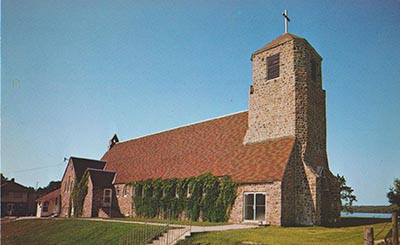JULY 24, 2024 – For four days running we successfully entertained Russ and Kerri, our Red Cabin sojourners from afar. I say “successfully,” because they didn’t up and leave before their time, though admittedly, to do so, they would have to have stolen our keys—and car. Or walk. In fairness to my wife and me, however, we can be perfectly tolerable hosts, especially when Mother Nature in all her splendour is on full display.
We spent the vast portion of our time “on the premises” or aboard our pontoon, Northern Comfort, crisscrossing Grindstone Lake. Yet, we did exhibit episodes of off-premise adventurism—a walk to Spring Lake and back with a stop at secluded Petty Lake; a trip into Hayward, the tchotchke center eight miles away serving tourists for many more miles around, where we skipped the souvenirs in favor of homemade ice cream at West’s Dairy; dinner on Sunday evening at Trail’s End, a well-kempt old-style resort with bar and restaurant and outdoor seating. The resort stands among countless regal white pine and lines the shore on the back arm of 5,000-acre Lac Courte Oreilles, the next lake down in “our” chain of lakes. The food and drinks were fine, but the highlight at Trail’s End was our rewarding exchange with the server, whose primary job is recruiter for Lac Courte Oreilles University on the nearby Lac Courte Oreilles Tribe of the Band of Lake Superior Chippewa Indians.
Little could we have anticipated that our chat with the cheerful, self-assured server would be the prelude to a most memorable experience the next day.
Beth had wisely suggested to our guests that they might enjoy visiting the St. Francis Solanus Mission church, school and cemetery on the quiet shores of Little Lac Courte Oreilles south of and adjoining (big) Lac Courte Oreilles. Over the decades, Beth and I had visited the place several times and could vouch for its quiet authenticity. Russ and Kerri were game.
Tuesday morning we piled into the car and drove into the heart of the LCO reservation. We slipped onto the mission grounds unnoticed and parked near the old stone church. A large banner outside announced that the all-pipestone building is 100 years old this year. We let ourselves in to admire the simple beauty of the structure, adorned with the embroidery donated by members and stained-glass windows featuring native themes. From there we toured the adjacent cemetery, noting the number of Indian veterans of America’s wars of the 20th century. It was not lost on us that these veterans had fought the wars of a country that had decimated their ancestors and corralled the veterans themselves within “reservations.”
We then strolled over to the school building which looked unchanged (though reasonably well maintained) since I’d first laid eyes on it more than a half century ago. From past visits Beth and I knew that the main attraction was the “souvenir shop” that occupied a former classroom, stocked to the gills with goods made by local hands, including everything from baked goods to beadwork and jewelry to scale model hogans made of birchbark to an impressive inventory of large beautiful quilts. One of the more impressive quilts was always the subject of a raffle for $1.00 per ticket.
One sign informed us that the school and souvenir shop were “open,” but another handwritten note instructed visitors to ring at the nearby convent if they wished to see the school or shop; of course, that was our desire.
Soon a sister answered the door. Tall, thin, and bearing white hair, she wore a royal blue dress, which matched the color of her eyes. She leaned on a single crutch, and her advanced age commanded our immediate respect. (Cont.)
Subscribe to this blog and receive notifications of new posts by email.
© 2024 by Eric Nilsson
